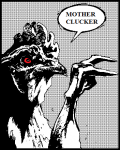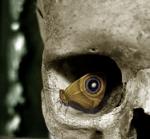I've got a link to some 61 pictures of a Tibetan Skyburial. If anyone wants to see them and discuss them in this thread I'll PM them to you, but I wont be posting the link since these pictures violate the "no pictures of gore" part of the Code of Conduct. Of course, if a moderator previews the link and OKs them, I can post it here, but I don't expect that will happen.
Bacially the pictures depict a dead man being laid out on a barren field, he is stripped naked and secured to the ground with a rope and a pike of some sort. A guy "prepares" the body by laying a number of incisions criss crossing the body, laying open the body. Then the body is left alone and set upon by a large pack of vultures that strip the corpse to the bone in a seemingly very short time. The pictures are not bloody or unnecessarily "graphic", most are taken from a far (maybe out of respect all though it doesn't seem that "official"), but there is a dead body and pictures of the left overs and what happens with the rest of the bones.
To be honest it's probably one of the most primitive yet surprisingly natural death rituals I've ever seen, which is why I thought it would be an interesting and thought provoking topic for the discussion board. I don't think anyone needs to to see the pictures to discuss the topic, but it certainly is something different. I always thought I wanted to have my ashes dumped into the sea or thrown out of an airplane but this would be pretty damn cool as well. Apparently it is done because the soil is very thin and rocky, so they have to improvise.
http://en.wikipedia....l&printable=yes
Quote
From Wikipedia, the free encyclopedia
Sky burial or ritual dissection was once a common funerary practice in Tibet wherein a human corpse is cut in specific locations and placed on a mountaintop, exposing it to the elements or the mahabhuta and animals – especially to birds of prey. In Tibetan the practice is known as jhator (Tibetan: བྱ་གཏོར་; Wylie: bya gtor), which literally means, "giving alms to the birds."
The majority of Tibetans adhere to Buddhism, which teaches rebirth. There is no need to preserve the body, as it is now an empty vessel. Birds may eat it, or nature may let it decompose. So the function of the sky burial is simply the disposal of the remains. In much of Tibet the ground is too hard and rocky to dig a grave, and with fuel and timber scarce, a sky burial is often more practical than cremation.
History and development
The Tibetan sky-burial practices appear to have evolved out of practical considerations:[1][2][3] a) most of Tibet is above the tree line, and the scarcity of timber makes cremation economically unfeasible;
Purpose and meaning
As the name implies, jhator is considered an act of generosity: the deceased and his/her surviving relatives are providing food to sustain living beings. Generosity and compassion for all beings are important virtues or paramita in Buddhism. Although some observers have suggested that jhator is also meant to unite the deceased person with the sky or sacred realm, this does not seem consistent with most of the knowledgeable commentary and eyewitness reports, which indicate that Tibetans believe that at this point life has completely left the body and the body contains nothing more than simple flesh.
The government of the People's Republic of China, which has controlled Tibet since 1950, prohibited the practice (which it considered barbaric) in the 1960s but started to allow it again in the 1980s.[6] Non-Tibetans are usually not permitted to observe it, and direct photography is considered unethical, offensive and is generally forbidden.
A jhator was filmed, with permission from the family, for Frederique Darragon's documentary Secret Towers of the Himalayas, which aired on the Science Channel in Fall 2008. The camera work was deliberately careful to never show the body itself, while documenting the procedure, birds, and tools.
Vajrayana iconography
The tradition and custom of the jhator afforded Traditional Tibetan medicine and thangka iconography with a particular insight into the interior workings of the human body. Pieces of the human skeleton were employed in ritual tools such as the skullcup, thigh-bone trumpet, etc.
The 'symbolic bone ornaments' (Skt: aṣṭhiamudrā; Tib: rus pa'i rgyanl phyag rgya) are also known as "mudra" or 'seals'. The Hevajra Tantra identifies the Symbolic Bone Ornaments with the Five Wisdoms and Jamgon Kongtrul in his commentary to the Hevajra Tantra explains this further.[7]
Setting
This section does not cite any references or sources. Please help improve this article by adding citations to reliable sources. Unsourced material may be challenged and removed. (February 2009)
A traditional jhator is performed in specified locations in Tibet (and surrounding areas traditionally occupied by Tibetans). Drigung Monastery is one of the three most important jhator sites.
The procedure takes place on a large flat rock long used for the purpose. The charnel ground (durtro) is always higher than its surroundings. It may be very simple, consisting only of the flat rock, or it may be more elaborate, incorporating temples and stupa (chorten in Tibetan).
Relatives may remain nearby[8] during the jhator, possibly in a place where they cannot see it directly. The jhator usually takes place at dawn.
The full jhator procedure (as described below) is elaborate and expensive. Those who cannot afford it simply place their deceased on a high rock where the body decomposes or is eaten by birds and animals.
Procedure
This section does not cite any references or sources. Please help improve this article by adding citations to reliable sources. Unsourced material may be challenged and removed. (February 2009)
Accounts from observers vary. The following description is assembled from multiple accounts by observers from the U.S. and Europe. References appear at the end.
Participants
Prior to the procedure, monks may chant mantra around the body and burn juniper incense – although ceremonial activities often take place on the preceding day.
The work of disassembling of the body may be done by a monk, or, more commonly, by rogyapas ("body-breakers").
All the eyewitness accounts remarked on the fact that the rogyapas did not perform their task with gravity or ceremony, but rather talked and laughed as during any other type of physical labor. According to Buddhist teaching, this makes it easier for the soul of the deceased to move on from the uncertain plane between life and death onto the next life.
Disassembling the body
In one account, the leading rogyapa cut off the limbs and hacked the body to pieces, handing each part to his assistants, who used rocks to pound the flesh and bones together to a pulp, which they mixed with tsampa (barley flour with tea and yak butter or milk) before the vultures were summoned to eat.
In several accounts, the flesh was stripped from the bones and given to vultures without further preparation; the bones then were broken up with sledgehammers, and usually mixed with tsampa before being given to the vultures. Many rogyapa first feed the bones and cartilage to the vultures, keeping the best flesh until last. After having had their fill of good quality meat, the birds usually fly away - leaving the bones and less favored bits.
In another account, vultures were given the whole body. When only the bones remained, they were broken up with mallets, ground with tsampa, and given to crows and hawks that had waited until the vultures had departed.
Sometimes the internal organs were removed and processed separately, but they too were consumed by birds. The hair is removed from the head and may be simply thrown away; at Drigung it seems at least some hair is kept in a room of the monastery.
None of the eyewitness accounts specifies what kind of knife is used in the jhator. One source states that it is a "ritual flaying knife" or trigu (Sanskrit kartika), but another source expresses skepticism, noting that the trigu is considered a woman's tool (rogyapas seem to be exclusively male).
Vultures
The species of vulture involved is apparently the "Eurasian Griffon" or "Old World vulture," Order Falconiformes, Family Accipitridae, scientific name Gyps fulvus.
In places where there are several jhator offerings each day, the birds sometimes had to be coaxed to eat, which in one case was accomplished by a ritual dance. It is considered a bad omen if the vultures will not eat, or if even a small portion of the body is left after the birds fly away.
In places where fewer bodies are processed, the vultures were more eager and sometimes had to be fended off with sticks during the initial preparations.
This post has been edited by Aptorian: 15 September 2009 - 04:25 PM

 Help
Help

















